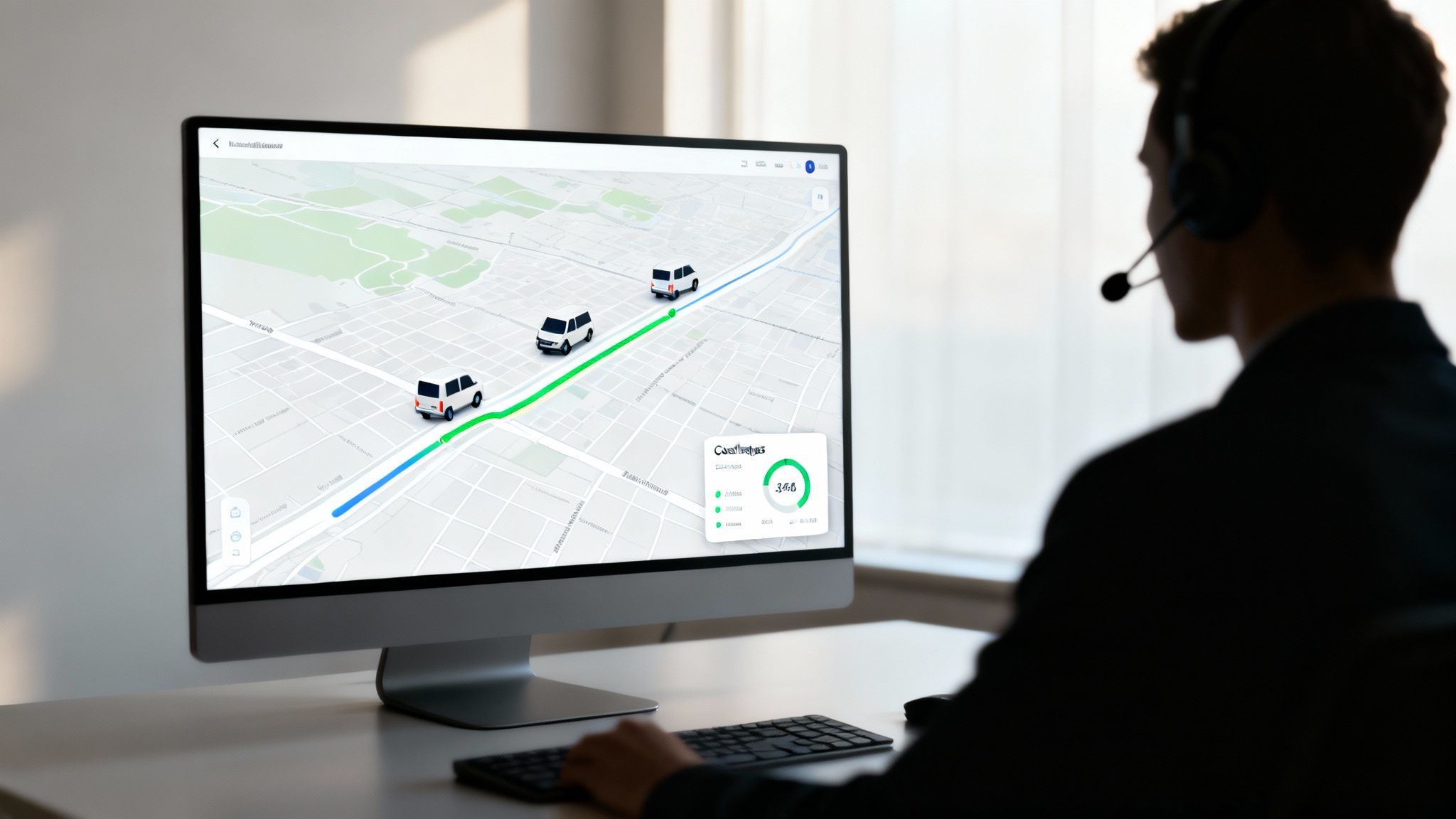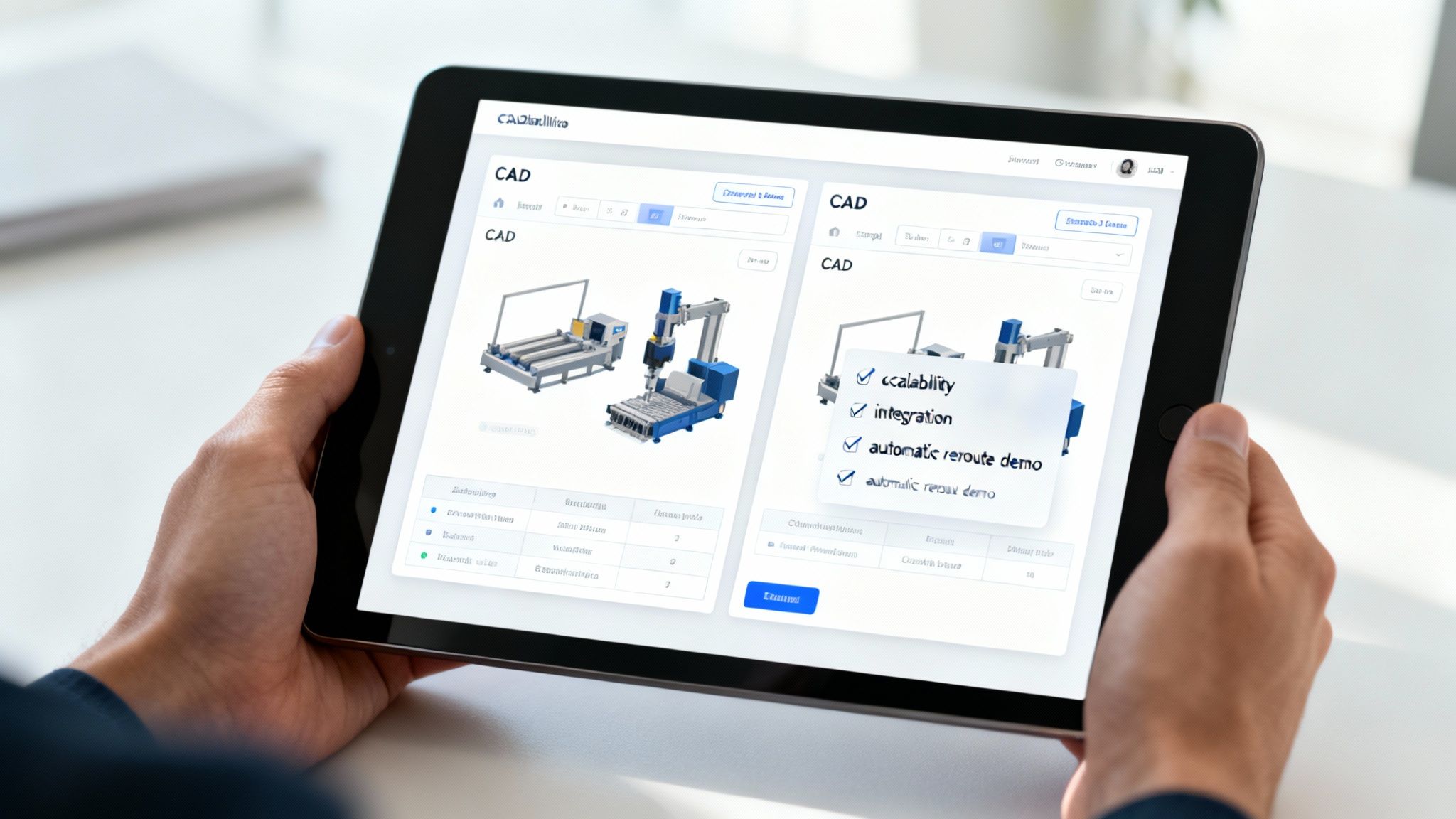A Guide to Your CAD Dispatch System
At its core, a CAD dispatch system is the digital command center for any organization that has people or assets out in the field. It’s the engine that takes incoming calls and service requests and turns them into clean, organized, and actionable tasks. The goal is simple: get the right resources to the right place at the right time.
This tech is the backbone for a huge range of operations, from emergency services like fire and police all the way to commercial businesses like plumbing, HVAC, or logistics companies.
What a CAD Dispatch System Actually Does
Think of an air traffic controller managing dozens of planes. They aren't just watching dots on a screen; they’re actively coordinating takeoffs, landings, and flight paths to prevent absolute chaos. A Computer-Aided Dispatch (CAD) system does pretty much the same thing, but for units on the ground. It’s the operational brain that brings order to complex, real-time situations.
It's way more than just a piece of software; it's a complete workflow engine. When a call for service comes in, the system instantly logs the details, pinpoints the location on a digital map, and often suggests the best available unit for the job. This creates a seamless flow of information from the first call to the moment the job is marked complete.
The Core Operational Workflow
When you boil it down, a CAD dispatch system follows a clear, repeatable process built for speed and accuracy. This workflow makes sure no detail gets lost in the shuffle and that every action is tracked—something that's just as important for auditing and reporting as it is for the immediate response.
This infographic lays out the basic flow: a call comes in, a unit gets dispatched, and the incident is resolved.
This simple three-step process—Call, Dispatch, Resolve—is the foundation of how these systems create efficiency and restore order, whether it's an emergency or a routine service call.
To get a bit more granular, the process really breaks down into a few key stages. Here’s a table that maps out the typical journey of a service request inside a CAD system.
The Core Stages of a CAD Dispatch Workflow
| Stage | Description | Key Action |
|---|---|---|
| Event Creation | An incident is reported, either through a phone call, an automated alert, or a digital request. | The dispatcher enters all critical details into the system: location, incident type, and caller information. |
| Unit Recommendation | The system analyzes the location and requirements of the event. | It identifies and suggests the closest, most appropriate available units based on real-time data. |
| Dispatch | The dispatcher assigns the recommended (or another) unit to the event. | The selected unit receives the assignment and all relevant details directly on their mobile device. |
| Status Monitoring | The dispatcher tracks the unit's progress in real time. | The unit updates its status (e.g., en route, on-scene, clear) throughout the event. |
| Resolution & Reporting | The unit completes the job and closes out the event. | All data—from timestamps to notes—is logged, creating a complete digital record for future analysis. |
Each stage is designed to feed into the next, creating a clear, auditable trail that improves accountability and helps teams learn from past events.
Actionable Insight Saving You Money
Let's look at a local plumbing company. Without a CAD system, a dispatcher might take a call and just send the job to a plumber who seems closest, having no idea they're actually stuck in a massive traffic jam.
With a CAD system, the dispatcher sees real-time vehicle locations and live traffic data. They can assign the job to the truly closest plumber with the clearest route.
Practical Example: A plumbing company in a major city saves an average of 1.5 gallons of fuel per vehicle, per day, just by using optimized routing. For a fleet of 10 vans, that's over $1,500 in fuel savings each month.
Actionable Insight: This simple optimization also lets the company squeeze at least one extra paying job into each technician's day. That small change can add up to tens of thousands of dollars in new revenue annually per vehicle, dramatically boosting profitability without increasing overhead.
A Growing Market Driven by Efficiency
This push for smarter, more efficient operations is fueling massive growth. The global Computer-Aided Dispatch market was valued at around USD 2.576 billion in 2024 and is projected to more than double to USD 5.541 billion by 2035. This boom is largely driven by the move to cloud-based solutions and the integration of AI to further automate and optimize dispatching. You can learn more about the factors driving the CAD market's rapid expansion.
For businesses, this trend points to a clear competitive advantage. A modern CAD system isn't just for massive emergency service agencies anymore. It's a strategic move for any service-based business that wants to eliminate waste and make customers happier. By automating the most tedious parts of dispatching, you free up your people to handle more complex problems—and that directly impacts the bottom line.
The Features That Drive Real Savings

A modern CAD dispatch system isn't just some digital logbook. It's a powerhouse toolkit where every single feature is built to make your operation smoother and cut down on costs. The key is understanding how these tools actually translate into real-world savings—seeing the system not as an expense, but as a money-saving asset.
Let's break down the core features that deliver a tangible return. These aren't just abstract ideas; they are practical fixes for common headaches like wasted fuel, clumsy scheduling, and slow response times that hit your bottom line directly.
Real-Time Vehicle Tracking and AVL
At the heart of any solid CAD system is Automatic Vehicle Location (AVL). Picture a live, interactive map showing you the exact position of every unit in your fleet, right now. This isn't just about knowing where your people are; it's about making smarter calls, minute by minute.
Practical Example: A local security firm gets an alarm. Without AVL, the dispatcher might just send the patrol car assigned to that zone, completely unaware that another unit is just two blocks away, wrapping up a routine check.
With AVL, the dispatcher instantly sees the closest available officer on their screen. They can send that unit, slashing response time and saving the fuel that would've been burned by the more distant car.
Actionable Insight: By taking the guesswork out of the equation, real-time tracking transforms your dispatch center from a reactive call-taker into a proactive command hub. This efficiency boost means the firm can handle more calls without needing more cars on the road, directly saving on vehicle acquisition, insurance, and labor costs.
Automated Dispatching and Resource Allocation
Dispatching by hand can be slow and, especially under pressure, full of mistakes. Automated dispatching features use smart algorithms to assign the best unit for the job based on rules you set, taking a huge weight off the dispatcher's shoulders.
The system can juggle multiple factors at once:
- Proximity: Which unit can get there the fastest?
- Status: Which units are actually free and not tied up on another call?
- Skills/Equipment: Does this job need a specific certification or a tool that only certain units have?
Practical Example: An HVAC company gets a call for a complex commercial refrigeration unit repair. The CAD system automatically scans for technicians who are not only nearby and available but also have the specific "Level 3 Refrigeration" certification required for the job. This prevents sending an unqualified technician, which would result in a wasted trip and an angry customer.
Actionable Insight: Intelligent allocation makes sure the right asset is sent the first time, preventing costly delays or the need for a second truck roll. You can explore the various dispatching features available in modern systems to see how they can be tailored to eliminate these money-wasting mistakes.
Integrated Mapping with Live Traffic Data
Static, old-school maps are a thing of the past. A good CAD system plugs into dynamic mapping services that feed it live traffic updates, road closure alerts, and the most efficient routes. This feature alone is a massive money-saver.
Practical Example: Imagine a delivery company trying to navigate rush hour. A driver gets sent on a standard route that's now a parking lot because of an accident. The CAD system, seeing the live traffic data, automatically finds a new, faster route and sends it directly to the driver's in-cab terminal.
Actionable Insight: That simple reroute saves fuel, cuts down on vehicle wear and tear, and gets the delivery there on time. Over a year, that adds up to hundreds of dollars saved per vehicle in fuel costs alone, not to mention protecting the company's reputation for being reliable, which is key to customer retention and future revenue.
Finding Your ROI in a CAD System
It's a common mistake to look at a CAD dispatch system and see only a line-item expense. The reality is, it’s a strategic investment, one that should generate a clear and measurable return. The real value isn't just in the software; it's in the operational efficiencies and cost reductions it creates across your entire organization. We're talking about turning operational data into a powerful story of financial gain.
The first and most obvious place you'll see savings is in your fleet's fuel consumption. Optimized routing algorithms instantly find the most efficient path for every dispatch, steering drivers away from traffic jams and shaving off unnecessary mileage. For a field service company with just 10 vehicles, even a small reduction can slash hundreds of dollars from the fuel bill each month, adding up to thousands in annual savings.
This isn't just about fuel, either. Faster, smarter routes mean your team can handle more jobs in the same amount of time, boosting your revenue potential without needing to hire more staff or buy more trucks.
Slashing Overtime and Boosting Productivity
Inefficient dispatching is one of the biggest drivers of overtime costs. When the wrong unit gets sent, or when jobs are scheduled without thinking about location and travel time, the workday gets stretched out for no good reason. A CAD system tackles this head-on by making sure the most logical unit is always assigned to the job.
Practical Example: A landscaping company used to schedule jobs based on the order they came in. Technicians would crisscross the city all day, often finishing their last job late and racking up overtime. With a CAD system, jobs are automatically grouped by geographic zone. Technicians now complete a tight cluster of jobs before moving to the next area.
Actionable Insight: A CAD system directly converts operational efficiency into payroll savings. This smarter resource allocation drastically cuts down on wasted time between jobs, helping your team wrap things up within standard hours. By automating scheduling and routing, you can eliminate the unnecessary overtime that erodes your budget.
Then there's the administrative headache. Manual reporting and data entry eat up countless hours that could be spent on much more valuable work. A modern CAD system automates this entire process, generating detailed reports on response times, unit productivity, and incident types with just a few clicks. This frees up your admin staff and leadership to focus on strategic analysis instead of getting buried in spreadsheets.
Calculating Your Potential Return
To build a strong business case for a CAD dispatch system, you need to run the numbers for your specific operation. You can use a simple framework to get a good estimate of the financial impact.
- Calculate Fuel Savings: Figure out your fleet's average monthly fuel cost. A conservative estimate of a 10-15% reduction from optimized routing gives you a solid baseline for monthly savings.
- Estimate Labor Cost Reduction: Take a hard look at your monthly overtime pay. A more efficient dispatch process can easily cut this down by 20-30% or more.
- Quantify Administrative Efficiency: Estimate how many hours your team spends on manual reporting and log entries each week. Convert those hours into a dollar amount to see the real value of automation.
Add those three figures together, and you’ll get a clear picture of the potential monthly savings. This financial roadmap helps justify the investment and shows the system's true value. As you explore your options, it helps to see a breakdown of costs. You can check out a variety of transparent pricing models for CAD systems to find one that fits your budget and operational needs.
On-Premises vs Cloud-Based CAD Deployment Costs
When deciding on a new system, one of the biggest financial hurdles is choosing between an on-premises or a cloud-based solution. They have completely different cost structures that will impact both your initial investment and your long-term expenses.
Here’s a quick look at how they stack up.
| Cost Factor | On-Premises CAD | Cloud-Based CAD |
|---|---|---|
| Initial Investment | High upfront costs for servers, hardware, and software licenses. | Low or no upfront cost; typically a predictable monthly/annual subscription fee. |
| Maintenance | Ongoing costs for IT staff, hardware upgrades, and maintenance. | Maintenance, updates, and security are included in the subscription fee. |
| Scalability | Expensive and complex to scale; requires purchasing new hardware. | Easily scalable; plans can be adjusted as your organization grows or shrinks. |
| Accessibility | Limited to on-site or VPN access, making remote work difficult. | Accessible from any device with an internet connection, ideal for field use. |
Actionable Insight: For most organizations today, a cloud-based CAD solution offers a much more predictable and lower-cost entry point. It eliminates the massive capital expense of buying and maintaining your own hardware, freeing up cash for other critical business needs and making advanced dispatch technology accessible even for smaller agencies and businesses.
How to Choose the Right CAD System

Choosing a CAD dispatch system feels like a massive decision, and honestly, it is. But you can cut through the noise by breaking the process down into a simple, practical checklist. The goal isn't to find the system with the longest list of features; it's about finding the one that actually solves your day-to-day problems and gives you a real return on your investment.
This guide will help you see past the slick sales pitches. We'll focus on the criteria that truly matter, making sure you end up with a solution that fits your organization like a glove—not some generic, one-size-fits-all product.
Define Your Core Needs First
Before you even think about watching a demo, you need a rock-solid understanding of what you actually need the system to do. Every organization is unique. A local plumbing company has entirely different priorities than a multi-jurisdictional public safety agency.
Start by making two lists: your "must-haves" and your "nice-to-haves." This simple exercise is your best defense against getting distracted by flashy features you'll never use.
- Practical Example (Public Safety): An agency's "must-haves" include seamless integration with their existing Records Management System (RMS) for compliance and reporting, pre-arrival instruction prompts for medical calls, and mutual aid features to work with neighboring fire departments.
- Practical Example (Commercial Fleet): A logistics company's "must-haves" are solid route optimization, real-time integration with their customer relationship management (CRM) software to update job statuses automatically, and automated customer notifications (e.g., "Your driver is 15 minutes away").
Actionable Insight: Doing this homework upfront is the single most powerful thing you can do to narrow the field. It prevents you from overspending on capabilities you don't need, ensuring every dollar of your investment targets a specific operational problem.
Ask the Right Questions During a Demo
A sales demo is your shot to see the software in action, but if you ask generic questions, you'll get generic answers. You have to push vendors to show you how their system handles the real-world scenarios you deal with every single day.
So, instead of asking, “Does your system have mapping?” try getting specific:
"Can you show me how your system would automatically reroute a unit around a major traffic jam that just got reported on the news? Then, show me how that new route gets pushed to the driver's mobile device instantly."
This kind of pointed, scenario-based question forces them to demonstrate real functionality, not just tick a box on a feature sheet. It reveals just how intuitive and effective the CAD dispatch system is when things get messy.
Prioritize Scalability and Integration
Your organization isn't going to stay the same size forever. A good CAD system needs to be able to grow with you without forcing you into a complete—and expensive—overhaul down the road. This is where cloud-based solutions really shine.
The shift to cloud-based CAD is a huge trend, and for good reason. It’s all about flexibility and cost savings. The market was pegged at USD 2.73 billion in 2024 and it’s still climbing because cloud platforms offer lower upfront costs and top-notch security, making them a great fit for organizations of any size.
Just as important is how well the system plays with your other software. Make a list of every tool you depend on—from billing software to HR platforms—and make sure the vendor has proven, pre-built integrations for them.
Actionable Insight: A system that can’t talk to your other tools will create costly manual workarounds. For example, if your CAD doesn't integrate with your billing software, someone will have to manually re-enter all job details to create an invoice. This introduces errors and wastes valuable administrative time that could be eliminated with proper integration.
Evaluate Vendor Support and Security
Finally, remember you’re not just buying a piece of software; you're starting a long-term partnership with the vendor. The quality of their support team is every bit as important as the technology itself. Ask them about their support hours, average response times, and what their training programs look like.
And of course, security is completely non-negotiable. Your CAD system is going to be handling sensitive operational and customer data, which makes it a prime target. Dig into their security protocols, data encryption standards, and any compliance certifications they hold.
A Practical Roadmap for Implementation

Getting your hands on a powerful CAD dispatch system is one thing. Actually getting it rolled out smoothly is another story entirely. It's the make-or-break moment. Even the best software on the planet is useless if your team fights it every step of the way.
This is our practical roadmap for getting it done right. We'll walk through the key stages, from moving your old data over to getting full team buy-in. The goal is to make your new system a genuine asset from day one, not just another headache. A good rollout is about people first, technology second.
Stage 1: Assemble Your Implementation Team
Before you even think about the software, you need to build your team. This isn't just a job for IT or the front office. You need a group that represents every corner of your operation.
Most importantly, you must include your most experienced dispatchers and field personnel. These are the folks who live and breathe your workflows every day. They'll spot potential roadblocks and friction points that managers and tech guys would never see coming.
Getting them involved early does two things. First, it ensures the system gets configured to work for them, not against them. Second, it creates a sense of ownership. Your key players become advocates for the change, and that buy-in is the single most critical factor for a successful launch.
Stage 2: Data Migration and System Configuration
With the right people in the room, it's time to tackle the data. This means pulling all your existing records—client addresses, site histories, unit details—into the new CAD dispatch system. You'll want to work closely with your vendor here to make sure this process is clean.
Once the data is in place, configuration begins. This is where your implementation team really shines. They'll help you dial in the system to match exactly how you operate:
- Setting Up Geofences: Drawing the digital boundaries for your operational zones.
- Customizing Event Types: Building out templates for the specific calls and jobs you handle most often.
- Defining User Roles: Deciding who gets access to what, from dispatchers and supervisors to the crews in the field.
Practical Example: A private ambulance service configures its CAD with a special event type for "Non-Emergency Patient Transport." This template automatically includes fields for patient insurance information and required medical equipment, ensuring crews have everything they need before they leave the station.
Actionable Insight: Put your senior dispatchers in charge of building out these event templates. They know precisely what information is vital for every call type. This simple move makes data entry faster, cuts down on errors, and gets new dispatchers up to speed in record time, reducing training costs and improving operational accuracy.
Stage 3: Training and a Phased Rollout
A well-configured system is nothing without a confident team to run it. Training is the bridge that gets you there. Don't fall into the trap of a one-size-fits-all training day. It just doesn't work.
Instead, create role-specific training. Your dispatchers need to master the call-taking and unit management screens. Your field crews need to become experts on their mobile terminals. Focus on what each person actually does.
Actionable Insight: Resist the urge to do a "big bang" launch. A phased rollout is almost always the smarter, cheaper play. Start with a small pilot group or a single shift. Let them use the system in a live environment, work out the kinks, and gather feedback. This lets you fix problems on a small scale before they impact the entire organization and require costly, widespread re-training. It builds momentum and makes the full transition feel a whole lot smoother.
Frequently Asked Questions
Jumping into the world of dispatch tech can bring up a lot of questions. I get it. You want to know about the real-world stuff—cost, setup time, and how it all works day-to-day. Let's tackle some of the most common things people ask when looking at a CAD dispatch system.
How Long Does It Typically Take to Implement a New System?
Honestly, it depends. The timeline can swing pretty wildly based on how complex your operation is and the kind of system you're getting.
Practical Example: If you're a small field service business with straightforward needs (e.g., 15 trucks, basic job types), a cloud-based solution could be up and running in just a few weeks. That’s usually enough time for the basic setup, importing your customer list, and getting your team through some online training.
But for bigger outfits, like a public safety agency or a large logistics company, you're looking at a more involved process. Plan for anywhere from 3 to 9 months. This longer runway is necessary to get everything right—digging into your workflows, customizing the software, and linking it up with other critical tools like records management or billing systems.
Actionable Insight to Save Money: Want to speed things up and cut down on those expensive implementation hours? Map out your exact workflows before you even start. If you know precisely how you want calls handled, units dispatched, and reports generated, the configuration process will fly by. This little bit of prep work helps you avoid paying a vendor's "discovery" fees just to figure out your own processes.
Can a CAD System Integrate with Our Existing Software?
Absolutely. Integration is one of the biggest strengths of any modern CAD system, but how easy it is really comes down to the vendor. Most reputable companies build their software with robust APIs (Application Programming Interfaces), which are basically pre-built connectors designed to talk to other tools.
We often see integrations with:
- Records Management Systems (RMS) for police and fire departments.
- Electronic Patient Care Reporting (ePCR) for EMS and ambulance services.
- Billing and Accounting Software for businesses looking to automate invoicing.
- GPS/AVL Hardware that's already installed in your vehicles.
Actionable Insight: Before you sign on the dotted line, hand the vendor a complete list of all your current software and hardware. The most important step here is to ask for case studies or to speak with other clients who've done similar integrations. Getting that proof is the best way to make sure you're building a truly connected system and not setting yourself up for expensive surprises and custom development fees down the road.
What Is the Biggest Hidden Cost When Adopting a CAD System?
The software license or subscription fee is what everyone sees first, but the biggest hidden cost is often a lack of good training and user adoption. It's simple: if your team isn't trained properly, they won't use the system to its full potential. All that ROI you were expecting? Gone. They might even fall back on old, clunky methods out of pure frustration.
Another sneaky cost is data migration. Shifting years of incident reports, customer addresses, and mapping data from an old system into a new one can be a real headache. Vendors know this, and they often charge a pretty penny for this specialized work.
Actionable Insight to Save Money: Instead of paying for one-off training classes every few months, try negotiating a "train-the-trainer" program. The vendor can do a deep-dive training with a few of your key people, turning them into in-house experts. They can then handle all ongoing training for new hires and current staff. It's a much more cost-effective way to keep everyone up to speed. Always ask for a detailed quote that breaks down every single cost—implementation, data migration, training, and support—to see the true total cost.
How Does a CAD System Improve Safety for Field Personnel?
A CAD dispatch system is a huge safety multiplier because it gives everyone in the field better situational awareness. It's that simple. With real-time GPS tracking, dispatchers can see the exact location of every unit. When a situation gets hairy and backup is needed right now, that's not a small detail—it's everything.
Practical Example: A police officer is on a traffic stop that turns hostile. They can hit the digital "panic button" on their mobile data terminal (MDT). The CAD system instantly creates a high-priority "officer needs assistance" call, broadcasting the officer's exact GPS coordinates to all nearby units without the officer needing to say a word on the radio.
Dispatchers can also push critical info directly to a unit's MDT. This could be anything from premise history (like knowing about previous violent incidents at an address) to specific hazard warnings.
By making sure the closest and most appropriate unit is always sent, the system doesn't just cut down response times for the public; it slashes them for your own team members who need help. It's all about that constant, accurate flow of information. It ensures your people are better prepared and fully supported when they walk into the unknown.
Ready to see how a modern, cost-effective CAD solution can transform your operations? Resgrid offers a comprehensive, open-source platform designed for first responders and businesses alike, with no contracts or costly implementation fees. Learn more and get started with Resgrid today!

